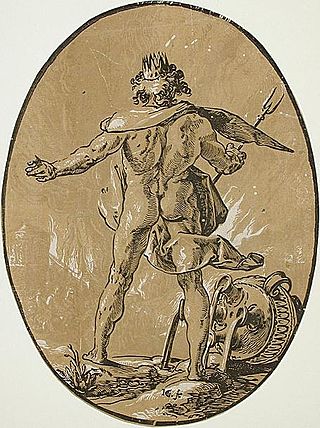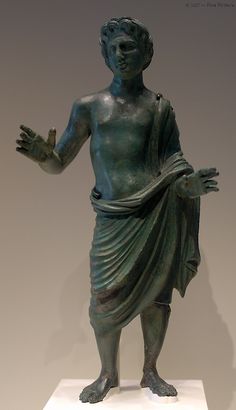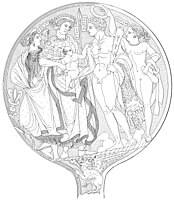
Etruscan religion comprises a set of stories, beliefs, and religious practices of the Etruscan civilization, heavily influenced by the mythology of ancient Greece, and sharing similarities with concurrent Roman mythology and religion. As the Etruscan civilization was gradually assimilated into the Roman Republic from the 4th century BC, the Etruscan religion and mythology were partially incorporated into ancient Roman culture, following the Roman tendency to absorb some of the local gods and customs of conquered lands. The first attestations of an Etruscan religion can be traced back to the Villanovan culture.
In Etruscan religion, Fufluns or Puphluns was a god of plant life, happiness, wine, health, and growth in all things. He is mentioned twice among the gods listed in the inscriptions of the Liver of Piacenza, being listed among the 16 gods that rule the Etruscan astrological houses. He is the 9th of those 16 gods. He is the son of Semla and the god Tinia. He was worshipped at Populonia and is the namesake of that town.

In Etruscan mythology and religion, Laran is the god of war. In art, he was portrayed as a naked youth wearing a helmet, a cuirass and carrying a spear, shield, or lance. Laran also appears to be an underworld god. Among his attributes is his responsibility to maintain peace. According to some scholars, he also seems to have been the guardian of boundaries as shown by the boundary cippi found in Bettona with the inscriptions tular Larna and tular larns. Along with eight other Etruscan gods, he can wield lightning. Due to the Tabula Capuana we know that the Laran festival was celebrated on the Ides of May. Laran is the Etruscan equivalent of the Greek Ares and the Roman Mars. Like many other Etruscan gods, his name is gender neutral.

Menrva was an Etruscan goddess of war, art, wisdom, and medicine. She contributed much of her character to the Roman Minerva. She was the child of Uni and Tinia.

Tages was claimed as a founding prophet of Etruscan religion who is known from reports by Latin authors of the late Roman Republic and Roman Empire. He revealed a cosmic view of divinity and correct methods of ascertaining divine will concerning events of public interest. Such divination was undertaken in Roman society by priestly officials called haruspices.
In Etruscan religion and myth, Thalna was a divine figure usually regarded as a goddess of childbirth. Determinate gender, however, is not necessarily a characteristic of Etruscan deities, and Thalna is also either depicted as male, or seems to be identified as a male figure because of the placement of names around a scene. Her other functions include friendship and prophecy. Her name may mean "growth, bloom." She appears in Etruscan art in the company of Turan, Tinia, and Menrva.

In Etruscan Religion and mythology, Thesan is the Etruscan goddess of the dawn, divination, and childbirth and was associated with the generation of life. Romans identified her with their Aurora and Mater Matuta and Greeks with Eos and Leucothea. In Etruria, she received offerings together with the sun god Usil in the liber linteus. She was especially worshipped at Caere's harbour of Pyrgi, where a temple was dedicated to her and a singular series of ‘‘daybreak antefixes’’ was excavated.

In Etruscan religion, Turms was the equivalent of Roman Mercury and Greek Hermes, both gods of trade and the messenger god between people and gods. He was depicted with the same distinctive attributes as Hermes and Mercury: a caduceus, a petasos, and/or winged sandals. He is portrayed as a messenger of the gods, particularly Tinia (Jupiter), although he is also thought to be ‘at the service’ (ministerium) of other deities.

In Etruscan religion, Hercle, the son of Tinia and Uni, was a version of the Greek Heracles, depicted as a muscular figure often carrying a club and wearing a lionskin. He is a popular subject in Etruscan art, particularly bronze mirrors, which show him engaged in adventures not known from the Greek myths of Heracles or the Roman and later classical myths of Hercules.
Maris was an Etruscan god often depicted as an infant or child and given many epithets, including Mariś Halna, Mariś Husrnana, and Mariś Isminthians. He was the son of Hercle, the Etruscan equivalent of Heracles. On two bronze mirrors, Maris appears in scenes depicting an immersion rite presumably to ensure his immortality. Massimo Pallottino noted that Maris might have been connected to stories about the centaur Mares, the legendary ancestor of the Ausones, who underwent a triple death and resurrection.

Turan was the Etruscan goddess of love, fertility and vitality and patroness of the city of Velch.

Uni is the ancient goddess of marriage, fertility, family, and women in Etruscan religion and myth, and was the patron goddess of Perugia. She is identified as the Etruscan equivalent of Juno in Roman mythology, and Hera in Greek mythology. As the supreme goddess of the Etruscan pantheon, she is part of the Etruscan trinity, an original precursor to the Capitoline Triad, made up of her husband Tinia, the god of the sky, and daughter Menrva, the goddess of wisdom.

Usil is the Etruscan god of the sun, shown to be identified with Apulu (Apollo). His iconic depiction features Usil rising out of the sea, with a fireball in either outstretched hand, on an engraved Etruscan bronze mirror in late Archaic style, formerly on the Roman antiquities market. On Etruscan mirrors in the Classical style, Usil appears with an aureole.

A bident is a two-pronged implement resembling a pitchfork. In Greek mythology, the bident is a weapon associated with Hades (Pluto), the ruler of the underworld.

The Three Revelers Vase, also known as simply the Revelers Vase, is a Greek vase originating from the Archaic Period. Painted around 510 BCE in the red figure pottery style, the Revelers vase was found in an Etruscan tomb in Vulci, Italy. The painting is attributed to Euthymides. Although the vase is in the amphora shape, its purpose is more decorative than functional. The painting itself shows three nude partygoers and Hector arming on the reverse. The work is remarkable because of the early use of foreshortening as opposed to conventional profile and frontal views. The Revelers Vase currently resides in the Staatliche Antikensammlungen in Münich, Germany.

The Belly Amphora in the Staatliche Antikensammlungen at Munich is one of the most famous works by the Andokides Painter. The vase measures 53.5 cm high and 22.5 cm in diameter. It dates to between 520 and 510 BC and was discovered at Vulci. It was acquired by Martin von Wagner, an agent of Ludwig I of Bavaria.
Leinth is an Etruscan deity. Within Etruscan iconography, it is difficult to distinguish mortals from divine figures without inscriptions. Inscriptions to the god Leinth have only been identified on two bronze mirrors and a single fragment of ceramic, found within an artisan’s zone on an Etruscan site in Italy. It is difficult, with such little evidence, to determine what may seem to be even the most rudimentary qualities of the deity, because the Etruscans did not consistently assign specific genders or attributes to their gods. Leinth appears both as a male and a female on two different bronze mirrors, and aside from the inscription, there seem to be no distinguishing traits to connect the figures.

Ethausva is an Etruscan divine figure that appears in a few Etruscan inscriptions. She is depicted as a winged female richly robed and wearing a jeweled crown on her head. Her lack of mention on Etruscan artwork and inscriptions suggest that she was not very common, but she was considered canon to the Etruscan Pantheon so she was still known during the time of the Etruscans.

Culsans (Culśanś) is an Etruscan deity, known from four inscriptions and a variety of iconographical material which includes coins, statuettes, and a sarcophagus. Culśanś is usually rendered as a male deity with two faces and at least two statuettes depicting him have been found in close association with city gates. These characteristics suggest that he was a protector of gateways, who could watch over the gate with two pairs of eyes.

Lur is an Etruscan underworld deity with not much known history. Lur does not have many depictions but the ones that have been found show the deity as a male. He has been noted to be associated with a prophetic nature, while also bearing oracular and martial characteristics. He has been linked to another deity by the name of Laran, which, it has been suggested, is where Lur derives his name from. The context of the name has been associated with darkness and the underworld. A fifth century vase found near a sanctuary in San Giovenale bears an inscription that translates: "I am Lurs, that of Laran." Another inscription has been found with the spelling lartla, noting relations to a Lar, which gives a label to Lur that describes features of protection. The name may be related to Latin luridus "pale".























